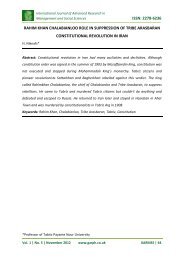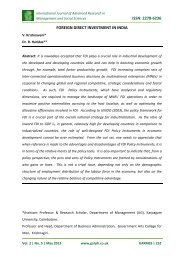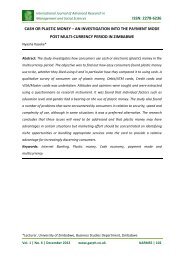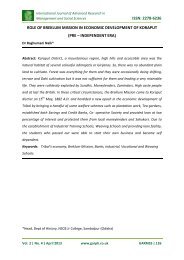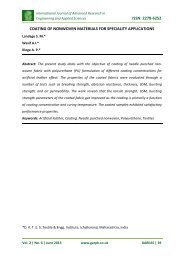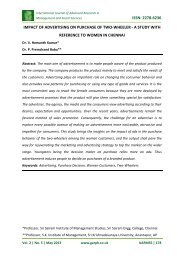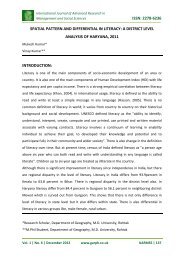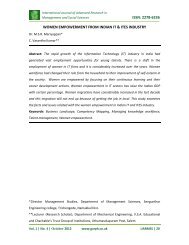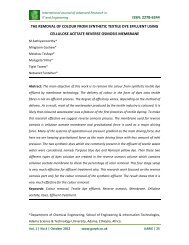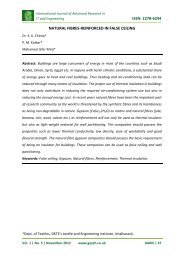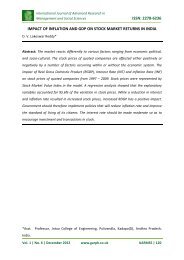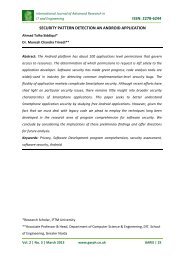issn: 2278-6252 material handling in textile industries - Garph.co.uk
issn: 2278-6252 material handling in textile industries - Garph.co.uk
issn: 2278-6252 material handling in textile industries - Garph.co.uk
You also want an ePaper? Increase the reach of your titles
YUMPU automatically turns print PDFs into web optimized ePapers that Google loves.
International Journal of Advanced Research <strong>in</strong><br />
Eng<strong>in</strong>eer<strong>in</strong>g and Applied Sciences ISSN: <strong>2278</strong>-<strong>6252</strong><br />
Dr. Devanand Uttam*<br />
MATERIAL HANDLING IN TEXTILE INDUSTRIES<br />
Abstract: Textile mill <strong>co</strong>nsumes a huge amount of raw <strong>material</strong> for <strong>co</strong>nversion of raw<br />
<strong>material</strong> to f<strong>in</strong>al products. The mills are us<strong>in</strong>g a large number of mach<strong>in</strong>es and processes.<br />
Dur<strong>in</strong>g <strong>co</strong>nversion of raw <strong>material</strong> to end product; <strong>material</strong> moves from one department to<br />
other, one mach<strong>in</strong>e to other mach<strong>in</strong>e and from one floor to other. Day by day, production of<br />
each mach<strong>in</strong>e is go<strong>in</strong>g up. To achieve the target of production, the mill management is<br />
fac<strong>in</strong>g the challenge of safe, efficient and e<strong>co</strong>nomical <strong>material</strong> <strong>handl<strong>in</strong>g</strong>. In this paper it is<br />
tried to provide the required knowledge of <strong>material</strong> <strong>handl<strong>in</strong>g</strong> <strong>in</strong> reference to <strong>textile</strong> mills.<br />
Keywords: Material <strong>handl<strong>in</strong>g</strong>, <strong>material</strong> transport, <strong>material</strong> <strong>handl<strong>in</strong>g</strong> equipment.<br />
*Department of Textile Eng<strong>in</strong>eer<strong>in</strong>g, Giani Zail S<strong>in</strong>gh Punjab Technical University Campus,<br />
Bath<strong>in</strong>da (Punjab) INDIA<br />
Vol. 2 | No. 6 | June 2013 www.garph.<strong>co</strong>.<strong>uk</strong> IJAREAS | 52
International Journal of Advanced Research <strong>in</strong><br />
Eng<strong>in</strong>eer<strong>in</strong>g and Applied Sciences ISSN: <strong>2278</strong>-<strong>6252</strong><br />
1. INTRODUCTION<br />
Material <strong>handl<strong>in</strong>g</strong> can be def<strong>in</strong>ed as: “art and science of <strong>co</strong>nvey<strong>in</strong>g, elevat<strong>in</strong>g, position<strong>in</strong>g,<br />
transport<strong>in</strong>g, packag<strong>in</strong>g and stor<strong>in</strong>g of <strong>material</strong>s Start<strong>in</strong>g from the time, the raw <strong>material</strong><br />
(such as fibres for sp<strong>in</strong>n<strong>in</strong>g unit or yarns for weav<strong>in</strong>g/ knitt<strong>in</strong>g unit and fabrics for wet<br />
process<strong>in</strong>g or garment<strong>in</strong>g units) enters the mill gate and goes out of the mill gate <strong>in</strong> the<br />
form of f<strong>in</strong>ished products; it is handled at all stages with<strong>in</strong> mill boundaries such as with<strong>in</strong><br />
and between raw <strong>material</strong> stores, various section of production department, mach<strong>in</strong>e to<br />
mach<strong>in</strong>e and f<strong>in</strong>ished product stores. A <strong>material</strong> may be handled even 50 times or more<br />
before it changes to f<strong>in</strong>ished product. It has been estimated that average <strong>material</strong> <strong>handl<strong>in</strong>g</strong><br />
<strong>co</strong>st is roughly 10-30% of the total production <strong>co</strong>st depend<strong>in</strong>g upon product to process. By<br />
sav<strong>in</strong>g <strong>in</strong> the <strong>material</strong> <strong>handl<strong>in</strong>g</strong> <strong>co</strong>st, the <strong>co</strong>st of production can be reduced <strong>co</strong>nsiderably.<br />
Material <strong>handl<strong>in</strong>g</strong> <strong>in</strong>volves the movement of <strong>material</strong>s, manually or mechanically <strong>in</strong> batches<br />
or one item at a time with<strong>in</strong> the plant. The movement may be horizontal, vertical or the<br />
<strong>co</strong>mb<strong>in</strong>ation of these two.<br />
Material movement adds to the <strong>co</strong>st but not to the product value. The ideal mill would have<br />
an absolute m<strong>in</strong>imum of <strong>material</strong>s <strong>handl<strong>in</strong>g</strong> and more use of mechanical <strong>material</strong> <strong>handl<strong>in</strong>g</strong><br />
equipments. The shortage of labour and <strong>in</strong>creas<strong>in</strong>g wages <strong>co</strong>st demand the most efficient<br />
use of labour. Proper <strong>material</strong> <strong>handl<strong>in</strong>g</strong> offers benefits for:<br />
i. improv<strong>in</strong>g productivity<br />
ii. <strong>in</strong>creas<strong>in</strong>g the <strong>handl<strong>in</strong>g</strong> capacity<br />
iii. reduc<strong>in</strong>g man-power<br />
iv. <strong>in</strong>creas<strong>in</strong>g the speed of <strong>material</strong> movement<br />
v. reduc<strong>in</strong>g <strong>material</strong>s wastage<br />
vi. promot<strong>in</strong>g easier and cleaner <strong>handl<strong>in</strong>g</strong><br />
vii. elim<strong>in</strong>at<strong>in</strong>g idle time of mach<strong>in</strong>es, equipment and workers<br />
viii. reduce fatigue <strong>in</strong>curred by the workers<br />
ix. <strong>in</strong>creas<strong>in</strong>g safety and m<strong>in</strong>imis<strong>in</strong>g accidents<br />
x. locate and stock <strong>material</strong> better and <strong>in</strong> less space<br />
xi. m<strong>in</strong>imis<strong>in</strong>g production <strong>co</strong>st, etc.<br />
Vol. 2 | No. 6 | June 2013 www.garph.<strong>co</strong>.<strong>uk</strong> IJAREAS | 53
International Journal of Advanced Research <strong>in</strong><br />
Eng<strong>in</strong>eer<strong>in</strong>g and Applied Sciences ISSN: <strong>2278</strong>-<strong>6252</strong><br />
2. FUNCTIONS OF MATERIAL HANDLING SECTION<br />
There are basically two functions of <strong>material</strong> <strong>handl<strong>in</strong>g</strong> section:<br />
1. To select production mach<strong>in</strong>ery and assist <strong>in</strong> plant layout so as to elim<strong>in</strong>ate as far as<br />
possible the need of <strong>material</strong> <strong>handl<strong>in</strong>g</strong>. For examples: <strong>in</strong> a sp<strong>in</strong>n<strong>in</strong>g mills chute feed<br />
cards, open end sp<strong>in</strong>n<strong>in</strong>g mach<strong>in</strong>e, auto-doff<strong>in</strong>g r<strong>in</strong>g frames and auto<strong>co</strong>ner etc.<br />
reduce the <strong>material</strong> <strong>handl<strong>in</strong>g</strong> activities hence <strong>material</strong> <strong>handl<strong>in</strong>g</strong> <strong>co</strong>st.<br />
2. To choose most appropriate <strong>material</strong> <strong>handl<strong>in</strong>g</strong> equipment which is safe and can<br />
fulfill <strong>material</strong> <strong>handl<strong>in</strong>g</strong> requirements at the m<strong>in</strong>imum possible overall <strong>co</strong>st. For<br />
example: Air <strong>co</strong>nveyor pipes <strong>in</strong> with<strong>in</strong> the blow-room and between blow-room and<br />
cards, big size plastic <strong>co</strong>nta<strong>in</strong>er trolley for <strong>handl<strong>in</strong>g</strong> r<strong>in</strong>g frame bobb<strong>in</strong>s, <strong>co</strong>nes and<br />
fabrics <strong>in</strong> a <strong>textile</strong> mill.<br />
3. PRINCIPLES OF MATERIAL HANDLING<br />
In general, pr<strong>in</strong>ciples of <strong>material</strong> <strong>handl<strong>in</strong>g</strong> are as under:<br />
i. M<strong>in</strong>imize the movements <strong>in</strong>volved <strong>in</strong> a production process.<br />
ii.<br />
iii.<br />
iv.<br />
M<strong>in</strong>imize the distance moved by adopt<strong>in</strong>g shortest routes.<br />
In order to speed up the <strong>material</strong> movements, employ mechanical aids <strong>in</strong> place of<br />
manual labour.<br />
For mov<strong>in</strong>g optimum number of pieces <strong>in</strong> one unit; use the pr<strong>in</strong>ciples of<br />
<strong>co</strong>nta<strong>in</strong>erization, unit load or palletization.<br />
v. Appropriate, standard, efficient, effective, flexible, safe and proper sized <strong>material</strong><br />
vi.<br />
vii.<br />
viii.<br />
ix.<br />
<strong>handl<strong>in</strong>g</strong> equipments should be selected.<br />
In order to m<strong>in</strong>imize back track<strong>in</strong>g and duplicate <strong>handl<strong>in</strong>g</strong>; change <strong>in</strong> sequence of<br />
production operations.<br />
If possible, utilize gravity for assist<strong>in</strong>g <strong>material</strong> movements wherever possible.<br />
To reduce damage to the <strong>material</strong>s dur<strong>in</strong>g <strong>handl<strong>in</strong>g</strong> and e<strong>co</strong>nomize <strong>material</strong><br />
<strong>handl<strong>in</strong>g</strong> process; design trolleys, packages, <strong>co</strong>nta<strong>in</strong>ers and drums etc.<br />
Handl<strong>in</strong>g equipments are so arranged that these should m<strong>in</strong>imize distances moved<br />
by products and at the same time <strong>handl<strong>in</strong>g</strong> equipments should not <strong>in</strong>terfere with<br />
other mach<strong>in</strong>e or operation.<br />
x. To avoid any <strong>in</strong>terruption <strong>in</strong> <strong>handl<strong>in</strong>g</strong>; <strong>material</strong> <strong>handl<strong>in</strong>g</strong> equipments should<br />
periodically be checked, repaired and ma<strong>in</strong>ta<strong>in</strong>ed.<br />
Vol. 2 | No. 6 | June 2013 www.garph.<strong>co</strong>.<strong>uk</strong> IJAREAS | 54
International Journal of Advanced Research <strong>in</strong><br />
Eng<strong>in</strong>eer<strong>in</strong>g and Applied Sciences ISSN: <strong>2278</strong>-<strong>6252</strong><br />
4. SELECTION OF MATERIAL HANDLING EQUIPMENTS<br />
There are two most important aspects for analyz<strong>in</strong>g or solv<strong>in</strong>g a <strong>material</strong> <strong>handl<strong>in</strong>g</strong> problem<br />
are: eng<strong>in</strong>eer<strong>in</strong>g aspect, and e<strong>co</strong>nomic aspect. Eng<strong>in</strong>eer<strong>in</strong>g factors <strong>in</strong>clude: the <strong>co</strong>ndition of<br />
exist<strong>in</strong>g build<strong>in</strong>g and plant layout, production processes and equipments, nature of<br />
<strong>material</strong>s and products to be handled, usefulness and effectiveness of exist<strong>in</strong>g <strong>material</strong><br />
<strong>handl<strong>in</strong>g</strong> equipment. The e<strong>co</strong>nomic factors <strong>in</strong>clude the <strong>co</strong>st of <strong>material</strong> <strong>handl<strong>in</strong>g</strong> equipment,<br />
operat<strong>in</strong>g <strong>co</strong>sts, repair and ma<strong>in</strong>tenance <strong>co</strong>sts and taxes etc.<br />
The choice of a particular equipment depends upon specific requirements or the <strong>co</strong>ndition<br />
of an <strong>in</strong>dustry. For selection of Material <strong>handl<strong>in</strong>g</strong> equipment, the follow<strong>in</strong>g factors should be<br />
taken <strong>in</strong>to ac<strong>co</strong>unt:<br />
i) Type/shape of <strong>material</strong>s to be transported: The size of <strong>material</strong>, its shape, weight,<br />
delicacy and its chances of gett<strong>in</strong>g damaged dur<strong>in</strong>g <strong>handl<strong>in</strong>g</strong> etc. should be <strong>co</strong>nsidered.<br />
ii)<br />
Mill build<strong>in</strong>g and layout: The route of <strong>material</strong> movement, width of doors and aisles,<br />
<strong>in</strong>equality <strong>in</strong> floor levels, height of the ceil<strong>in</strong>g, strength of floor and walls, <strong>co</strong>lumns and<br />
pillars etc. to a great extent <strong>in</strong>fluence the choice of a <strong>material</strong> <strong>handl<strong>in</strong>g</strong> equipments.<br />
iii)<br />
Mach<strong>in</strong>e production: Different mach<strong>in</strong>es have different outputs per unit time. The<br />
<strong>material</strong> <strong>handl<strong>in</strong>g</strong> equipment should be able to handle the maximum output.<br />
iv)<br />
Type of <strong>material</strong> flow pattern: A horizontal flow pattern will need trucks, overheads<br />
bridge cranes, <strong>co</strong>nveyors etc, whereas a vertical flow pattern will require elevators,<br />
<strong>co</strong>nveyors, pipes etc.<br />
v) Types of production: The selection of the <strong>material</strong> <strong>handl<strong>in</strong>g</strong> equipments depends a<br />
great extend on type of production such as: mass production and batch production.<br />
Conveyors are more suitable for mass production on fixed routes and powered trucks for<br />
batch production.<br />
vi)<br />
Other factors: Some other factors also <strong>co</strong>nsidered dur<strong>in</strong>g selection of <strong>material</strong><br />
<strong>handl<strong>in</strong>g</strong> <strong>co</strong>st are: <strong>co</strong>st of <strong>material</strong> <strong>handl<strong>in</strong>g</strong> equipment, <strong>handl<strong>in</strong>g</strong> <strong>co</strong>sts, life of the equipment<br />
and amount of care and ma<strong>in</strong>tenance required for the equipment.<br />
5. MATERIAL HANDLING EQUIPMENTS<br />
A wide range of <strong>material</strong> <strong>handl<strong>in</strong>g</strong> equipments is available <strong>in</strong> the market; which are suitable<br />
to the most of the <strong>in</strong>dustrial requirements. Material <strong>handl<strong>in</strong>g</strong> equipments are classed as:<br />
1. Industrial trucks: manual and powered<br />
Vol. 2 | No. 6 | June 2013 www.garph.<strong>co</strong>.<strong>uk</strong> IJAREAS | 55
International Journal of Advanced Research <strong>in</strong><br />
Eng<strong>in</strong>eer<strong>in</strong>g and Applied Sciences ISSN: <strong>2278</strong>-<strong>6252</strong><br />
2. Cranes: overhead bridge crane, jib crane and gantry crane<br />
3. Hoists : cha<strong>in</strong> type manual, electrical and pneumatic,<br />
4. Conveyors: belt <strong>co</strong>nveyors, roller <strong>co</strong>nveyor, drag <strong>co</strong>nveyor, bucket <strong>co</strong>nveyor, pipe<br />
l<strong>in</strong>e (pneumatic) <strong>co</strong>nveyor, cha<strong>in</strong> or cable <strong>co</strong>nveyor<br />
5. Monorail<br />
6. Slides and chutes<br />
7. Lift<br />
8. Tractors and trailers etc.<br />
In the <strong>textile</strong> mills, there are many types of <strong>material</strong>s viz. raw <strong>material</strong>s, purchased<br />
<strong>co</strong>mponents, <strong>material</strong> <strong>in</strong> process, f<strong>in</strong>ished goods, pack<strong>in</strong>g <strong>material</strong>, ma<strong>in</strong>tenance and repair<br />
supplies, scrape and waste etc. These <strong>material</strong>s are of various size, shape and specific<br />
features. For this purpose, mostly special and some general type <strong>material</strong> <strong>handl<strong>in</strong>g</strong><br />
equipments are used <strong>in</strong> <strong>textile</strong> <strong>in</strong>dustries.<br />
A. Material <strong>handl<strong>in</strong>g</strong> <strong>in</strong> sp<strong>in</strong>n<strong>in</strong>g units<br />
Types of <strong>material</strong> <strong>handl<strong>in</strong>g</strong> equipments used <strong>in</strong> the sp<strong>in</strong>n<strong>in</strong>g mills are as under [Table 1]:<br />
Table 1: Material <strong>handl<strong>in</strong>g</strong> <strong>in</strong> sp<strong>in</strong>n<strong>in</strong>g units<br />
S. Process Material Material <strong>handl<strong>in</strong>g</strong> Equipment<br />
No.<br />
1. From supplier to mill Cotton/polyester <strong>in</strong> bale Truck or tra<strong>in</strong> or ship<br />
form<br />
2. From truck to store Bale of raw <strong>material</strong> Manual 2, 3 or 4 wheeled truck<br />
3. Raw <strong>material</strong> store Bale<br />
Manual 2, 3 or 4 wheeled truck<br />
to mix<strong>in</strong>g section<br />
4. Mix<strong>in</strong>g to blow room<br />
l<strong>in</strong>e<br />
Loose <strong>co</strong>tton<br />
Special designed trolleys or lattice<br />
or suction<br />
5. Blow room to card Laps or loose <strong>co</strong>tton Specially designed trolley or Air<br />
pipe <strong>co</strong>nveyor and chute<br />
6. Card<strong>in</strong>g to draw Sliver cans Manual trolley or cans fitted<br />
Frame<br />
castrol wheels<br />
7. Draw Frames to Sliver cans Manual trolley or cans fitted<br />
Speed Frame<br />
castrol wheels<br />
8. Speed frame to r<strong>in</strong>g Rov<strong>in</strong>g bobb<strong>in</strong>s Manual trolley/Tapa or special<br />
frame<br />
designed trolley<br />
9. R<strong>in</strong>g frame doff<strong>in</strong>g R<strong>in</strong>g bobb<strong>in</strong>s Doff<strong>in</strong>g trolleys<br />
10 R<strong>in</strong>g frame to R<strong>in</strong>g bobb<strong>in</strong>s<br />
Specially designed plastic trolley<br />
w<strong>in</strong>d<strong>in</strong>g<br />
11 W<strong>in</strong>d<strong>in</strong>g to pack<strong>in</strong>g Cones Big size plastic trolley or special<br />
designed trolley<br />
Vol. 2 | No. 6 | June 2013 www.garph.<strong>co</strong>.<strong>uk</strong> IJAREAS | 56
International Journal of Advanced Research <strong>in</strong><br />
Eng<strong>in</strong>eer<strong>in</strong>g and Applied Sciences ISSN: <strong>2278</strong>-<strong>6252</strong><br />
i. From truck to mill stores<br />
In the most of the <strong>textile</strong> sp<strong>in</strong>n<strong>in</strong>g mills, raw <strong>material</strong> i. e. <strong>co</strong>tton or polyester or vis<strong>co</strong>se <strong>in</strong><br />
the forms of bale and other supplies are carried to mills by means of motor trucks. After<br />
arrival of trucks, <strong>co</strong>tton or manmade fibres bales are manually pushed down on the floor.<br />
These bales are transported with the help of 2, 3 or 4-wheeled <strong>in</strong>dustrial trucks/trolleys<br />
(Figure 1&2) for stor<strong>in</strong>g <strong>in</strong> godown one by one. This <strong>co</strong>nsumes time, requires more workers.<br />
Sometimes Forklifts (Figures 3) can be used to unload bales (2 or 3 at a time) directly from<br />
trucks, transport and stack them <strong>in</strong> godowns.<br />
Figure 1: 2-wheeled <strong>in</strong>dustrial trucks/trolleys<br />
trucks/trolleys<br />
Figure 2: 4-wheeled <strong>in</strong>dustrial<br />
Figure 3: Forklifts<br />
Figure 4: Platform trucks<br />
ii. From raw <strong>material</strong> store to mix<strong>in</strong>g department<br />
From godowns, bales are manually transported to the mix<strong>in</strong>g department us<strong>in</strong>g s<strong>in</strong>gle bale<br />
trolley. 2, 3 or 4-wheeled <strong>in</strong>dustrial trucks/trolleys manual or powered are utilised for<br />
<strong>handl<strong>in</strong>g</strong> the bales of raw <strong>material</strong> such as bales of <strong>co</strong>tton/polyester/vis<strong>co</strong>se etc.. Some<br />
times, mills can use platform trucks (Figure 4), by which a s<strong>in</strong>gle operator can transport up<br />
Vol. 2 | No. 6 | June 2013 www.garph.<strong>co</strong>.<strong>uk</strong> IJAREAS | 57
International Journal of Advanced Research <strong>in</strong><br />
Eng<strong>in</strong>eer<strong>in</strong>g and Applied Sciences ISSN: <strong>2278</strong>-<strong>6252</strong><br />
to 3 bales at a time and deliver them at the appropriate place <strong>in</strong> the mix<strong>in</strong>g department. If<br />
mix<strong>in</strong>g department is situated at an elevated place, forklifts can be used.<br />
iii. From mix<strong>in</strong>g to blow-room<br />
The raw <strong>material</strong> (such as <strong>co</strong>tton) from the mix<strong>in</strong>g to the bale breaker is transported by<br />
means of a mix<strong>in</strong>g trolley. Earlier this was done manually by hands or by us<strong>in</strong>g bamboo<br />
baskets which not only took more time but also caused <strong>co</strong>tton be<strong>in</strong>g dropped on floor<br />
lead<strong>in</strong>g to more waste and poor housekeep<strong>in</strong>g. In the, middle age, to reduce<br />
these<br />
disadvantages, special designed manual or mechanical ironl trolleys (Figure 5) are used for<br />
transport<strong>in</strong>g the <strong>material</strong> from mix<strong>in</strong>g stock to bale breaker. To supply bales near bale<br />
plucker mills can use platform trucks (Figure 4). Recently, lift-able spr<strong>in</strong>g type pedal<br />
operated mix<strong>in</strong>g trolley (Figure 6) is used to improve the <strong>material</strong> <strong>handl<strong>in</strong>g</strong>. This type of<br />
trolley can transport up to 30 kg of <strong>material</strong> at a time.<br />
Figure 5: Iron trolley<br />
Figure 6: Mix<strong>in</strong>g trolley<br />
iii. With<strong>in</strong> blow room l<strong>in</strong>e<br />
With<strong>in</strong> the open<strong>in</strong>g and clean<strong>in</strong>g mach<strong>in</strong>e the <strong>material</strong> is transported with the help of<br />
<strong>co</strong>nveyor belts (Figure 7). From <strong>in</strong>itial open<strong>in</strong>g mach<strong>in</strong>es, the <strong>co</strong>tton is shifted from one<br />
open<strong>in</strong>g mach<strong>in</strong>e to other by pneumatic pipes (blown air pipes <strong>co</strong>nveyor) with the help of<br />
exhaust fans and cages (Figure 8).<br />
Figure 7: Belt <strong>co</strong>nveyor<br />
Vol. 2 | No. 6 | June 2013 www.garph.<strong>co</strong>.<strong>uk</strong> IJAREAS | 58
International Journal of Advanced Research <strong>in</strong><br />
Eng<strong>in</strong>eer<strong>in</strong>g and Applied Sciences ISSN: <strong>2278</strong>-<strong>6252</strong><br />
Figure 8: Air pipe <strong>co</strong>nveyor<br />
iv. From blow room to card<strong>in</strong>g departments<br />
In <strong>co</strong>nventional mills, blow room laps are transported manually by the workers keep<strong>in</strong>g one<br />
lap at a time on the shoulder. Many mills are us<strong>in</strong>g special designed mechanical trolley to<br />
transport blow room laps to card<strong>in</strong>g section (Figure 9). It can handle 4 to 6 laps at a time.<br />
There is little possibility of any damage occurr<strong>in</strong>g to the laps s<strong>in</strong>ce they are already stacked<br />
vertically <strong>in</strong> blow room. Recently, with the advent of chute feed cards the blow room<br />
<strong>material</strong> handled by blown air pipe <strong>co</strong>nveyors and chute (Figure 10). In chute feed card, the<br />
chute feed the <strong>material</strong> to the liker-<strong>in</strong> of the card<strong>in</strong>g mach<strong>in</strong>e through feed roll and feed<br />
plate as <strong>in</strong> the case of lap feed.<br />
Figure 9: Trolley for blow room laps<br />
Figure 10: Chute feed<strong>in</strong>g system<br />
v. From card<strong>in</strong>g mach<strong>in</strong>e to draw frame and draw frame to speed frame<br />
The <strong>material</strong> delivered <strong>in</strong> the form of sliver at the card<strong>in</strong>g mach<strong>in</strong>e, <strong>co</strong>mber and draw frame<br />
is <strong>co</strong>llected <strong>in</strong> cans. Ac<strong>co</strong>rd<strong>in</strong>g to mach<strong>in</strong>e make and design, they may be various sizes such<br />
as can’s diameter is 14”, 16”, 42” or 48” etc. with and without wheels. (Figure 11).<br />
Vol. 2 | No. 6 | June 2013 www.garph.<strong>co</strong>.<strong>uk</strong> IJAREAS | 59
International Journal of Advanced Research <strong>in</strong><br />
Eng<strong>in</strong>eer<strong>in</strong>g and Applied Sciences ISSN: <strong>2278</strong>-<strong>6252</strong><br />
These cans (both full and empty) are to be transported between cards, draw frames,<br />
<strong>co</strong>mber preparatory mach<strong>in</strong>es, <strong>co</strong>mbers and fly frames. In many mills, cans are transported<br />
manually by dragg<strong>in</strong>g them on the floor. This practice would not only spoil the floor, damage<br />
the can and result <strong>in</strong> wastage of sliver but also <strong>co</strong>nsume more time. The trolley shown <strong>in</strong><br />
Figure 12. can be used to carry 3 or 4 cans at a time. For easy transportation, latest cans are<br />
of big size and hav<strong>in</strong>g wheels (caster) at bottom.<br />
Figure 11: Sliver cans<br />
Figure 12: Cans carry<strong>in</strong>g trolley<br />
vi. Sliver lap/ribbon lap mach<strong>in</strong>e to <strong>co</strong>mber<br />
The sliver/ribbon laps are generally transported to the <strong>co</strong>mbers manually, i. e. by carry<strong>in</strong>g<br />
one or two laps on hands at a time which takes a lot of time and also results <strong>in</strong> wastage of<br />
<strong>material</strong>. A special designed trolley (Figure 13) is mostly used to transport eight laps at a<br />
time. S<strong>in</strong>ce the design is simple and <strong>co</strong>mpact, it can be moved easy along narrow alley.<br />
Vol. 2 | No. 6 | June 2013 www.garph.<strong>co</strong>.<strong>uk</strong> IJAREAS | 60
International Journal of Advanced Research <strong>in</strong><br />
Eng<strong>in</strong>eer<strong>in</strong>g and Applied Sciences ISSN: <strong>2278</strong>-<strong>6252</strong><br />
Figure 13: Sliver/ribbon laps carry<strong>in</strong>g trolley<br />
vii. From speed frame to r<strong>in</strong>g frame<br />
In the <strong>co</strong>nventional practice, speed frame doffers normally keep the doffed bobb<strong>in</strong>s on the<br />
arms and then carry 6 to 8 bobb<strong>in</strong>s by hand to the storage place. This practice is not only<br />
laborious but also sometimes results <strong>in</strong> bobb<strong>in</strong>s fall<strong>in</strong>g on the floor and the rov<strong>in</strong>g <strong>material</strong><br />
gett<strong>in</strong>g spoiled. It is also cause <strong>in</strong>juries to the workers.<br />
Mostly, big size plastic <strong>co</strong>nta<strong>in</strong>er trolley is used for <strong>handl<strong>in</strong>g</strong> the <strong>material</strong> from speed frame<br />
to r<strong>in</strong>g frame. (Figure 14). It can handle one full doff of a speed frame bobb<strong>in</strong>s. Here,<br />
bobb<strong>in</strong>s are haphazardly stacked. This often causes damages especially at the bottom row.<br />
The most appropriate trolley for carry<strong>in</strong>g full bobb<strong>in</strong>s to r<strong>in</strong>g frames without caus<strong>in</strong>g any<br />
damage to the rov<strong>in</strong>g, is specially designed porcup<strong>in</strong>e type trolley (Figure 15). In this type of<br />
trolley, each bobb<strong>in</strong> is placed separately on a peg..<br />
Figure1 4: Big size trolley for speed frame Figure 15: Porcup<strong>in</strong>e type trolley for speed frame<br />
Vol. 2 | No. 6 | June 2013 www.garph.<strong>co</strong>.<strong>uk</strong> IJAREAS | 61
International Journal of Advanced Research <strong>in</strong><br />
Eng<strong>in</strong>eer<strong>in</strong>g and Applied Sciences ISSN: <strong>2278</strong>-<strong>6252</strong><br />
viii. Trolley for speed frame flyers<br />
At the time of speed frame ma<strong>in</strong>tenance or clean<strong>in</strong>g, the flyers are removed from the<br />
mach<strong>in</strong>e. This trolley (Figure 16) is used to carry all the flyers from the speed frame to<br />
ma<strong>in</strong>tenance store and ma<strong>in</strong>tenance store to speed frame.<br />
Figure 16: Trolley for speed frame flyers<br />
ix. From r<strong>in</strong>g frame doff trolley.<br />
To save <strong>co</strong>stly floor area <strong>in</strong> any <strong>in</strong>dustry, Doff<strong>in</strong>g Baskets are widely used <strong>in</strong> <strong>textile</strong> sp<strong>in</strong>n<strong>in</strong>g,<br />
r<strong>in</strong>g doubl<strong>in</strong>g, twist<strong>in</strong>g, f<strong>in</strong>ish<strong>in</strong>g and w<strong>in</strong>d<strong>in</strong>g sections. Easily stackable and can be easily<br />
mounted on the trolley for the ease of movement. These bobb<strong>in</strong>s from doff<strong>in</strong>g baskets are<br />
shifted to a small plastic <strong>co</strong>nta<strong>in</strong>er trolley (Figure 17) which carry the <strong>material</strong> to w<strong>in</strong>d<strong>in</strong>g<br />
department. In r<strong>in</strong>g frame, mostly, a trolley carry<strong>in</strong>g two <strong>co</strong>nta<strong>in</strong>ers of plastic (Figure 18) is<br />
used dur<strong>in</strong>g doff<strong>in</strong>g. In this, one <strong>co</strong>nta<strong>in</strong>er carries the empty bobb<strong>in</strong>s and the other for full<br />
bobb<strong>in</strong>s. One trolley must be given to each doffer.<br />
Figure 17: R<strong>in</strong>g frame trolley<br />
Figure 17: R<strong>in</strong>g frame doff<strong>in</strong>g trolley Figure 18: R<strong>in</strong>g frame doff<strong>in</strong>g trolley<br />
x. From r<strong>in</strong>g frame to w<strong>in</strong>d<strong>in</strong>g/doubl<strong>in</strong>g/reel<strong>in</strong>g.<br />
In some mills, doffed <strong>co</strong>ps are first transferred to bamboo baskets or big size metal<br />
<strong>co</strong>nta<strong>in</strong>ers and they are transported to post sp<strong>in</strong>n<strong>in</strong>g department <strong>in</strong> trolleys. This practice<br />
not only results <strong>in</strong> damages to some <strong>co</strong>ps (top layer of yarns) but also causes entanglement<br />
Vol. 2 | No. 6 | June 2013 www.garph.<strong>co</strong>.<strong>uk</strong> IJAREAS | 62
International Journal of Advanced Research <strong>in</strong><br />
Eng<strong>in</strong>eer<strong>in</strong>g and Applied Sciences ISSN: <strong>2278</strong>-<strong>6252</strong><br />
lead<strong>in</strong>g to yarn waste. In w<strong>in</strong>d<strong>in</strong>g department, the tenter has to transfer the <strong>co</strong>ps from<br />
these <strong>co</strong>nta<strong>in</strong>ers/baskets either to b<strong>in</strong>s or to other small <strong>co</strong>nta<strong>in</strong>ers. This would also result<br />
<strong>in</strong> entanglement of yarn lead<strong>in</strong>g to more waste.<br />
Instead of transferr<strong>in</strong>g the doffed <strong>co</strong>ps to the baskets, the plastic crates, which are used for<br />
doff<strong>in</strong>g, with <strong>co</strong>ps themselves can be loaded on the trolley and transported to the post<br />
sp<strong>in</strong>n<strong>in</strong>g section.<br />
xi. Post sp<strong>in</strong>n<strong>in</strong>g<br />
In many mills, full <strong>co</strong>nes are transported to the pack<strong>in</strong>g section by us<strong>in</strong>g basket or steel<br />
trolley. This practice would cause damages to the <strong>co</strong>nes. To avoid this, mills must use<br />
trolleys fitted with <strong>co</strong>ne holder pegs (Figure 19). When the <strong>co</strong>nes are kept <strong>in</strong> this trolley, it is<br />
easy to <strong>in</strong>spect them for package defects. This trolley can also be used to transport cheeses<br />
from doubler w<strong>in</strong>d<strong>in</strong>g mach<strong>in</strong>es to TFO twist<strong>in</strong>g/r<strong>in</strong>g doubl<strong>in</strong>g.<br />
Figure 19 : Trolleys fitted with <strong>co</strong>ne holder pegs<br />
xii. Pack<strong>in</strong>g section<br />
In many mills, packed <strong>co</strong>ne bags or cartons are transported to f<strong>in</strong>ished yarn go down by<br />
carry<strong>in</strong>g them manually. This reduce the capacity of <strong>material</strong> <strong>handl<strong>in</strong>g</strong> and some time it<br />
cause of <strong>material</strong> damage. To avoid this, a platform truck can be used.<br />
xiii. Stores section<br />
In modern mills where <strong>material</strong> and spares are stored <strong>in</strong> racks, electric order picker can be<br />
used to pick the required items.<br />
Vol. 2 | No. 6 | June 2013 www.garph.<strong>co</strong>.<strong>uk</strong> IJAREAS | 63
International Journal of Advanced Research <strong>in</strong><br />
Eng<strong>in</strong>eer<strong>in</strong>g and Applied Sciences ISSN: <strong>2278</strong>-<strong>6252</strong><br />
B. Material <strong>handl<strong>in</strong>g</strong> <strong>in</strong> weav<strong>in</strong>g units<br />
S. Process Material Material <strong>handl<strong>in</strong>g</strong> Equipment<br />
No.<br />
1. W<strong>in</strong>d<strong>in</strong>g <strong>co</strong>nes to<br />
warp<strong>in</strong>g<br />
Cones<br />
Conta<strong>in</strong>er plastic trolley or trolleys<br />
fitted with <strong>co</strong>ne holder pegs<br />
2. Warp<strong>in</strong>g beams to Warp<strong>in</strong>g beam<br />
Warp Beam Carrier<br />
siz<strong>in</strong>g<br />
3. Siz<strong>in</strong>g to beam<strong>in</strong>g Sized beam Manual 2 or 4 wheeled truck, Hoist<br />
4. Beam<strong>in</strong>g to loom Weave’s beam<br />
Special designed trolleys<br />
shed<br />
5. Loomshed to grey<br />
<strong>in</strong>pection<br />
Cloth beam<br />
Specially designed trolley<br />
i. Warp<strong>in</strong>g to siz<strong>in</strong>g<br />
Special designed equipments are used to carry warp beam (Figure 20) and to carry empty<br />
beam (Figure 21&22):<br />
Figure 20: Warp Beam Carrier<br />
Figure 21: Empty Beam Carrie<br />
The warp beam should be stacked on rails by which they will be held at a height above the<br />
floor and will be supported on barrel rather than on flanges. Beam can be stacked on<br />
vertical rackes (Figure 23). This method will require less space <strong>co</strong>mpared to the earlier., but<br />
separate beam lift<strong>in</strong>g arrangement are required for load<strong>in</strong>g and unload<strong>in</strong>g the beams. Either<br />
overhead mono-rail with a cha<strong>in</strong> lock or beam lift<strong>in</strong>g trucks can be used for this purpose.<br />
Figure 22: Double Warp Beam Carrier<br />
ii. Figure 23: Cloth Roll Stocker Trolley<br />
Vol. 2 | No. 6 | June 2013 www.garph.<strong>co</strong>.<strong>uk</strong> IJAREAS | 64
International Journal of Advanced Research <strong>in</strong><br />
Eng<strong>in</strong>eer<strong>in</strong>g and Applied Sciences ISSN: <strong>2278</strong>-<strong>6252</strong><br />
ii. Siz<strong>in</strong>g to beam<strong>in</strong>g<br />
The hoists are used to transport sized beam to beam<strong>in</strong>g. They can handle heavy <strong>material</strong><br />
through overhead space. However, they can serve only a limited area. Hoists are of tree<br />
type: electrical, cha<strong>in</strong> type and pneumatic (Figure 24).<br />
a. Electrical hoist b. Cha<strong>in</strong> hoist c. Pneumatic hoist<br />
Figure 24: Hoists<br />
iii. Beam<strong>in</strong>g to loom shed<br />
Safety is <strong>co</strong>nsidered to be the most important factor while <strong>handl<strong>in</strong>g</strong> these beams because of<br />
their size and weight. The weavers beam <strong>in</strong> <strong>co</strong>nvention mill transported by manual mathods<br />
Recently, a trolley which has a curved top surface (Figure 25) is used for <strong>handl<strong>in</strong>g</strong> weavers<br />
beam, so that a beam does not roll off while be<strong>in</strong>g moved from one place to another, is<br />
used. In modern units a special trolley is used for transportation of beams.<br />
iv. Loom shed to grey <strong>in</strong>spection<br />
The fabric should be transferred by us<strong>in</strong>g cloth roll doffer carrier (Figure 26). In some mills,<br />
use box type trolley hav<strong>in</strong>g castor wheels so that it can taken to the grey fold<strong>in</strong>g department<br />
carry<strong>in</strong>g at a time a number of cloth rolls depend<strong>in</strong>g upon the size.<br />
Figure 25: Hydraulic Beam Pallet Trolley<br />
Figure 26: Cloth Roll Doffer Carrier<br />
Vol. 2 | No. 6 | June 2013 www.garph.<strong>co</strong>.<strong>uk</strong> IJAREAS | 65
International Journal of Advanced Research <strong>in</strong><br />
Eng<strong>in</strong>eer<strong>in</strong>g and Applied Sciences ISSN: <strong>2278</strong>-<strong>6252</strong><br />
6. CONCLUSIONS<br />
Although <strong>in</strong> the market a large variety of <strong>material</strong> <strong>handl<strong>in</strong>g</strong> equipment available <strong>in</strong> which<br />
some are very <strong>co</strong>nventional and some are modern. Modern <strong>material</strong> <strong>handl<strong>in</strong>g</strong> equipments<br />
are e<strong>co</strong>nomical, safer and can handle more <strong>material</strong> <strong>in</strong> unit time than <strong>co</strong>nventional<br />
equipments. The <strong>material</strong> <strong>handl<strong>in</strong>g</strong> department basically perform two functions: elim<strong>in</strong>ate<br />
the need of <strong>material</strong> <strong>handl<strong>in</strong>g</strong> as for as possible by choos<strong>in</strong>g appropriate production<br />
mach<strong>in</strong>ery, and choose most appropriate <strong>material</strong> <strong>handl<strong>in</strong>g</strong> equipment which is safe,<br />
efficient and e<strong>co</strong>nomical. The selection of <strong>material</strong> <strong>handl<strong>in</strong>g</strong> ma<strong>in</strong>ly depends upon: Type of<br />
<strong>material</strong> to be handled, mill build<strong>in</strong>g, layout, speed & type of production (mass prodn or<br />
batch production) and <strong>material</strong> flow pattern. There are two most important factors for<br />
analyz<strong>in</strong>g or solv<strong>in</strong>g a <strong>material</strong> <strong>handl<strong>in</strong>g</strong> problem are : Eng<strong>in</strong>eer<strong>in</strong>g factors ,and E<strong>co</strong>nomic<br />
factors.<br />
7. REFERENCES<br />
1. Khanna, O. P., (2009), Material Handl<strong>in</strong>g, Industrial Eng<strong>in</strong>eer<strong>in</strong>g and Management,<br />
Published by Dhanpat Rai Publications(P) Ltd. New Delhi, pp 25.1 - 25.14<br />
2. Material Handl<strong>in</strong>g & Storage Equipment, Rabatex, Industries, Gujrat,<br />
.http://www.<strong>in</strong>diamart.<strong>co</strong>m/rabatex-<strong>in</strong>dustries/products.html#<strong>material</strong>-<strong>handl<strong>in</strong>g</strong>-storageequipment<br />
-Assessed on 02.06.13<br />
3. http://www.frontierpolymers.<strong>co</strong>m . -Assessed on 02.06.13<br />
4. A study on <strong>material</strong>s <strong>handl<strong>in</strong>g</strong> <strong>in</strong> sp<strong>in</strong>n<strong>in</strong>g mills, The Indian Textile Journal,<br />
http://www.<strong>in</strong>dian<strong>textile</strong>journal.<strong>co</strong>m/articles/FAdetails.asp?id=1308.<br />
5. Aswathapa, K. And Bhat, K.S. Production and operation management.<br />
6. Ratnam T. V. and Chellamani K. P., (2004), Ma<strong>in</strong>tenance Management <strong>in</strong> Sp<strong>in</strong>n<strong>in</strong>g,<br />
SITRA Manograph.<br />
7. Information on <strong>material</strong>s <strong>handl<strong>in</strong>g</strong> equipment provided by the<br />
manufacturers/suppliers.<br />
8. Tal<strong>uk</strong>dar, M.K., Sriramulu, P. K., Ajgaonkar, D. B.,(1998) Management of a loom shed<br />
- II, Weav<strong>in</strong>g, Mahajan Publication Pvt Ltd., Ahmedabad, India, pp533-575.<br />
Vol. 2 | No. 6 | June 2013 www.garph.<strong>co</strong>.<strong>uk</strong> IJAREAS | 66





